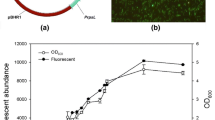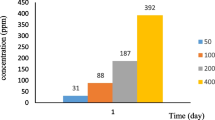Abstract
There is a strong need for effective and sustainable treatment methods for remediating soils and waters contaminated by fossil fuel pollutants such as aromatic hydrocarbons. Remediation could be improved by genetic bioaugmentation that uses conjugation of catabolic plasmids between bacteria. Research on the conditions for success, effectiveness, and long-term impact of genetic bioaugmentation are therefore necessary. Here the effects of genetic bioaugmentation with Pseudomonas putida BBC 443 was studied in continuous-flow soil columns with or without glucose amendment. Results show that the highest transconjugant occurrence of 21.7 ± 2.1 %, and development of microbial communities with the highest overall toluene degradation potential of 0.0790 ± 0.0055 mg toluene/g soil/h, were achieved in soil columns that received a continuous addition of 1 g/L glucose. Plasmid transfer and toluene biodegradation did not depend on the survival of donor P. putida BBC443, suggesting that genetic bioaugmentation was successful. Furthermore, bacterial community structure analysis revealed that genetic bioaugmentation had limited long-term impact on the soil bacterial community structures, regardless of the specific treatment. Our findings show that genetic bioaugmentation was successful and resulted in limited long-term ecological impact, thus demonstrating that genetic bioaugmentation can provide an effective and sustainable method for in situ bioremediation.



Similar content being viewed by others
References
Christensen BB, Sternberg C, Andersen JB, Eberl L, Moller S, Givskov M, Molin S (1998) Establishment of new genetic traits in a microbial biofilm community. Appl Environ Microbiol 64:2247–2255
Culman S, Bukowski R, Gauch HG, Cadillo-Qyuroz H, Buckley DH (2009) T-REX: software for the processing and analysis of T-RFLP data. BMC Bioinformatics 10:171
Girvan MS, Campbell CD, Killham K, Prosser JI, Glover LA (2005) Bacterial diversity promotes community stability and functional resilience after perturbation. Environ Microbiol 7:301–313
Goldstein RM, Mallory LM, Alexander M (1985) Reasons for possible failure of inoculation to enhance biodegradation. Appl Environ Microbiol 50:977–983
Hill KE, Top EM (1998) Gene transfer in soil systems using microcosms. FEMS Microbiol Ecol 25:319–329
Ikuma K, Gunsch CK (2010) Effect of carbon source addition on toluene biodegradation by an Escherichia coli DH5a transconjugant harboring the TOL plasmid. Biotechnol Bioeng 107:269–277
Ikuma K, Gunsch CK (2013) Functionality of the TOL plasmid under varying environmental conditions following conjugal transfer. Appl Microbiol Biotechnol 97:395–408
Ikuma K, Holzem RM, Gunsch CK (2012) Impacts of organic carbon availability and recipient bacteria characteristics on the potential for TOL plasmid genetic bioaugmentation in soil slurries. Chemosphere 89:158–163
Lukow T, Dunfield PF, Liesack W (2000) Use of the T-RFLP technique to assess spatial and temporal changes in the bacterial community structure within an agricultural soil planted with transgenic and non-transgenic potato plants. FEMS Microbiol Ecol 32:241–247
Martiny JBH, Field D (2005) Ecological perspectives on the sequenced genome collection. Ecol Lett 8:1334–1345
Popa O, Hazkani-Covo E, Landan G, Martin W, Dagan T (2011) Directed networks reveal genomic barriers and DNA repair bypasses to lateral gene transfer among prokaryotes. Genome Res 21:599–609
Riis V, Lorbeer H, Babel W (1998) Extraction of microorganisms from soil: evaluation of the efficiency by counting methods and activity measurements. Soil Biol Biochem 30:1573–1581
Sayler GS, Hooper SW, Layton AC, King JMH (1990) Catabolic plasmids of environmental and ecological significance. Microb Ecol 19:1–20
Top EM, Springael D, Boon N (2002) Catabolic mobile genetic elements and their potential use in bioaugmentation of polluted soils and waters. FEMS Microbiol Ecol 42:199–208
Wang S, Holzem RM, Gunsch CK (2008) Effects of pharmaceutically active compounds on a mixed microbial community originating from a municipal wastewater treatment plant. Environ Sci Technol 42:1091–1095
Acknowledgments
This work is based upon work supported by the National Science Foundation under Grant No. CBET-0846437. Any opinions, findings, and conclusions or recommendations expressed in this material are those of the author(s) and do not necessarily reflect the views of the National Science Foundation. The authors thank Dr. Søren Molin for the generous donation of P. putida strain BBC443.
Author information
Authors and Affiliations
Corresponding author
Rights and permissions
About this article
Cite this article
Ikuma, K., Gunsch, C.K. Successful genetic bioaugmentation with Pseudomonas putida for toluene degradation in soil columns. Environ Chem Lett 11, 365–370 (2013). https://doi.org/10.1007/s10311-013-0416-4
Received:
Accepted:
Published:
Issue Date:
DOI: https://doi.org/10.1007/s10311-013-0416-4




